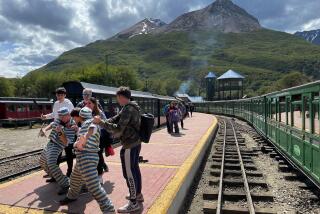Remains of a Tyrant Returned to Argentina Amid Cheers, Jeers
BUENOS AIRES — The exiled bones of 19th-Century tyrant Juan Manuel de Rosas ended their journey home from Britain on Sunday, transformed into a symbol of a nation’s quest to overcome its heritage of rancor, then and now.
Tens of thousands of Argentines joined ceremonies in the city of Rosario and small towns along a 200-mile stretch of the Parana River and the River Plate as Rosas’ renovated coffin floated downstream on the deck of a navy gunboat to Buenos Aires.
Wearing the red ribbons that Rosas once compelled his people to display, thousands of gauchos accompanied an army caisson in a procession from the port through downtown Buenos Aires, led by President Carlos Saul Menem. The remains were interred in Recoleta Cemetery, a resting place for the famed and powerful, including Evita Peron.
Rosas, who virtually ruled Argentina as governor of Buenos Aires province for all but three years from 1829 to 1852, thus belied poet Jose Marmol’s cry that “not even the dust of his bones” shall return to Argentine soil.
Menem, who took office in July and arranged for the return of Rosas’ remains, used the weekend-long festivities as a symbol in his campaign for national pride, unity and reconciliation. Many saw it as an attempt to win support for his expected pardon of military officers on trial for human rights offenses during the harsh dictatorship of 1976-83, when Menem himself was jailed for five years.
Banners were plastered on walls in the capital proclaiming, “Brig. Gen. Don Juan Manuel de Rosas: Welcome to the Fatherland Without Quarrels.”
The ceremonies largely avoided reopening the debate on Rosas’ role in Argentine history, still a contentious issue for scholars, 32 of whom recently offered contrasting views in a book on his reign. But by all accounts, Rosas was a prototype Latin American dictator.
‘Restorer of Laws’
Known variously as “the Caligula of the River Plate” and “the Restorer of Laws,” he built a ruthless secret police force, assassinated his foes and required citizens to wear his colors. He led the Federalists, who favored decentralized provincial rule over centralized government, but ended up being a de facto “unitarian,” with all power in his own hands.
Yet his rule also brought to an end the fratricidal civil wars that followed Argentina’s revolt against Spain beginning in 1810, and he fought off foreign attempts to dominate the young country.
One ceremony took place in Vuelta de Obligado, a village along the Parana where the river narrows. There, in 1845, Rosas’ forces defeated a British-French effort to land troops by stretching chains across the river.
Gauchos from neighboring farming districts, the source of Argentina’s wealth which began to flourish in Rosas’ day, lined a bluff. Soldiers let loose a 21-gun salute from cannons on the shore as bands played, fireworks burst overhead and air force jets flew by in formation.
Through the years, Rosas’ memory has been invoked by a disparate array of interests, from right-wing nationalists to anti-imperialist left-wing guerrillas, while many in the middle view him as the worst example of despotism. The repatriation itself also prompted disputes.
Alicia Jurado, a columnist for the conservative La Prensa, wrote: “Far from producing any reconciliation, all this will be a source of discord far more dangerous than the discreet forgetting that already had thrown its veil over the 19th Century. . . . Let’s not permit the rewriting of the past, nor forget the careers of its tyrants, if we want to protect our children from the aspiring tyrants of the future.”
Jurado added that she was worried about “the way in which so many (Argentines) concern themselves over the mortal remains of human beings. I long ago arrived at the conclusion that one of the features of our people is necrophilia.”
The hands of the body of Juan D. Peron, founder of the Peronist movement in the 1940s, were cut off in his tomb two years ago, and his second wife Evita’s corpse, embalmed after her death in 1952, became a national fixation. Secretly buried in Italy after then-President Peron was overthrown in 1955, the body was brought back to Argentina when Peron returned briefly to power in 1973 and later buried in Recoleta. Followers make pilgrimages to Evita’s grave to this day.
Family members had spent 55 years seeking the return of Rosas’ remains, buried in 1877 in Southampton, where he died at age 84. Rosas had been overthrown in 1852 and forced into exile in Britain, but he never ceased to awaken passions.
Small bands of ultra-rightists used Rosas as an excuse for anti-Semitism in the 1970s, and other Rosistas attacked the statue of his main rival, educator and President Domingo Faustino Sarmiento.
Theme of Unity
But Menem, who presided over a ceremony for Sarmiento last month, was determined to use the return of Rosas’ remains to underscore the theme of national unity rather than dwell on his place in history.
“Is it possible for us to continue tearing each other apart over old wounds?” Menem asked in a speech in Rosario. “You cannot build a true fatherland on the basis of hate between brothers. The feeling of the times is to say no to revenge, no to sectarianism, no to intolerance, no to the ghost of reviving our sad confrontations.
More to Read
Sign up for Essential California
The most important California stories and recommendations in your inbox every morning.
You may occasionally receive promotional content from the Los Angeles Times.










